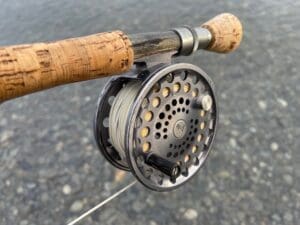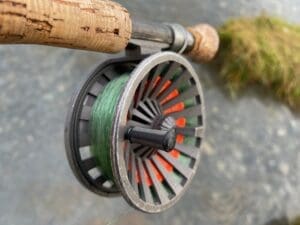Sockeye fishing on the Kenai River may look like an extremely simple act to the untrained eye, but the more time you spend on the famed gravel bars of the Kenai River, the more you realize that there are many ways to accomplish the “Kenai flip,” and in fact there are dozens of choices to be made in regards to tackle, rigging, and strategy. In this series we will cover all the most important aspects of being successful flossing sockeye on the Kenai River, including hook choices, weight choices, knots to utilize, the techniques involved, fighting sockeye, processing & preparing your catch, and the benefits & drawbacks of fishing with a fly rod vs. conventional gear…..Here we go!
PART 1 – FLY VS. CONVENTIONAL
When preparing to fish for sockeye salmon on the Kenai River one of the first choices you’ll have to make is what gear to select. There are benefits and drawbacks to both fly gear and conventional gear, and in all honesty, much of it comes down to personal preference.
Fly Rod Benefits:
- A fly rod setup is lighter than a conventional rod, making it much easier on your joints and muscles after hours of the repetitive motion that sockeye fishing demands.
- Fly line has a soft protective coating that allows the angler to finger the line and feel every bump and potential strike that is transmitted, without risking cuts from the line.
- Fly fishing is really, really FUN!
Fly Rod Drawbacks:
- Fly rods are typically built to be “slower” than a conventional rod, reducing your hook setting power.
- Many fly rod setups are more expensive than conventional alternatives.
- The knot that attaches your leader to your fly line creates a weak-link in your system.
- There is a bit of a learning curve for new fly anglers, resulting in an increase in lost fish during the fight.
Conventional Rod Benefits:
- Simple, cheap, and easy to rig.
- Faster rods provide more hook setting power.
- The automatic drag takes some of the human error out of the system, potentially decreasing the ratio of fish lost during the fight.
Conventional Rod Drawbacks:
- Monofilament line can cut your hand and fingers over time, so it’s difficult to use your fingers to feel the bumps and potential bites.
- Backlashes aka bird nests can be a problem when adjusting your line on a conventional reel.
- Conventional fishing gear isn’t as fun to use for some anglers.
- Most conventional setups are relatively heavy, causing angler fatigue more quickly than a lighter fly rod setup.
But what if I told you that you don’t have to choose between a standard fly rod set up, or a standard conventional setup? One of the most common setups you’ll find on the Kenai River today is the hybrid fly rod and fly reel combo loaded with monofilament line (see below). Sacrilegious to the purist fly angler, but downright deadly to the practical sockeye angler – the hybrid setup allows you to take advantage of many of the advantages of fly angling and conventional angling, while avoiding most of the drawbacks – a win-win for many. If this is the option you decide to go with, be sure to use at least 40lb. test line so you can fill up the spool fully, and also to avoid the line cutting into itself on the spool.
Every angler and guide has their personal favorite setup, and hopefully you’ll learn to enjoy and appreciate the benefits of the system you’re utilizing and make educated choices when selecting your own setup! Whatever setup you decide to go with, don’t forget to HAVE FUN in the process 🙂




0 Comments